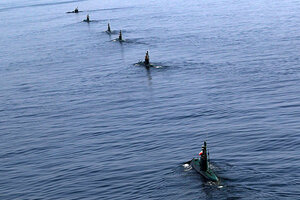US quietly prepares for naval clash with Iran in Strait of Hormuz
Iran is ramping up its production of mini-submarines, which are 'a huge problem' for US naval power. The US has countered by sending minesweepers to the region.

Iranian submarines participate in a naval parade on the last day of a war game in the Sea of Oman near the Strait of Hormuz earlier this year.
Ebrahim Norouzi/Reuters/File
Washington
Iran’s mini-submarines and Special Forces “frogmen” spell trouble for the US Navy
The Iranian military has a growing fleet of mini-submarines that is particularly difficult for the US Navy to detect and track. They are kitted out with torpedoes, highly-trained SEAL-like frogmen, and – most troublesome for the US military – mines that could threaten to shut down the vital Strait of Hormuz shipping lane.
In response, the commander of US forces in the region recently announced that the Navy would be doubling the number of its US minesweepers in the Gulf. The ranks of these minesweepers had remained steady for the past decade, but have risen from four to eight since June.
The ramped-up Iranian production of mini-submarines – as well as the Pentagon’s response – threatens to ratchet up military tensions in the region, analysts say.
The additional four Avenger-class minesweepers arrived in Bahrain on June 24. Along with the minesweepers, the Navy also sent additional minesweeping helicopters called “Sea Dragons.”
Their mission will be to counter the Iranian mini-submarines, which are “a huge problem for us,” says retired Navy Cmdr. Christopher Harmer, who from 2008 to 2009 was the director of future operations for the US Navy Fifth Fleet, stationed in Bahrain.
“They are a threat to us because they can disperse them throughout the Persian Gulf and the Arabian Sea, and it’s extremely difficult for us to track them,” he adds. As a result, they can lay "in wait to execute an ambush.”
The challenge of mini-subs
The US Navy is more accustomed to tracking large, Soviet-era nuclear-class submarines – something Iran knows well, adds Commander Harmer. “Looking for small subs in shallow water is much more difficult, because the acoustics are so much more difficult – smaller makes less noise.”
As a result, he adds, the Iranian military-industrial complex “has prioritized these mini-subs – and have gone into overdrive building them.” Mini-submarines are generally considered any submarine vessel under 500 tons and roughly 100 feet long or less.
Five years ago, the Iranian military had “no mini-subs,” says Harmer, senior naval analyst at the Institute for the Study of War in Washington. Now they have 19 in service, and are building an average of four per year – a “strategically significant” force, he adds.
While the diesel-electric powered Iranian mini-submarines have limited range, they have torpedo tubes and can quickly lay mines, which is their most troublesome feature, according to US military officials.
Iran also has “significant special operations capability,” including “extensively” trained frogmen, says Harmer. However, at a tactical level, the most likely use of Iranian frogmen would be against civilian targets such as oil tankers and other international commercial maritime traffic, he adds.
But if conflict between the US and Iran escalated militarily, Iran could also conceivably use its frogmen to attack a new pipeline that runs from the United Arab Emirates to the Gulf of Oman, a pipeline that bypasses the Straits of Hormuz.
The production of the mini-submarines is clear confirmation that while the average Iranian citizen has suffered greatly under Western sanctions, the Iranian military-industrial complex has not been affected “in any substantial way,” Harmer says.
The answer, he says, is to “substantially increase the sanctions – or acknowledge that they’re not working.”
Prospects for imminent war still small
Indeed, as the negotiations with Iran break down, “I think it’s almost inevitable that the military tensions in the Gulf increase,” says Michael Singh, former senior director for Middle East affairs at the National Security Council. “I think that it’s natural on one hand to see Western policymakers giving more serious thought to the use of military options to bolster our position in the Gulf.”
In response, “What you’re seeing is the Iranians beefing up their asymmetric naval warfare capabilities, as opposed to trying to take on the US Navy head-to-head.”
That said, “I don’t think war is imminent,” adds Mr. Singh, now managing director of the Washington Institute for Near East Policy. But it does make sense, he adds “to give credibility to your military threat so that the Iranians consider negotiations more seriously – and any red line you set down.”
Though the threat posed by Iranian mini-submarines is “valid,” the likelihood that Iran would use the submarines to threaten US interests in the region is “fairly small,” Harmer adds. “The Iranians know that if they try to mine the strait, the US Navy can clean it up” in “five or six days.”
It is also clear that the US Navy would view any mine-laying as a reason to “take military action to degrade the Iranian military,” he adds. “They know that in a straight-up fight, they cannot handle the American military. So they are trying to exercise as much influence and control without ever coming into outright conflict with the West.”
America, too, must choose its actions carefully. “You want them to have a real respect for military options, yet at the same time you don’t want to take it so far that you spark an inadvertent conflict in the process,” Singh says. “That’s the fine line you’ve got to walk.”

